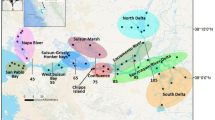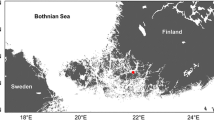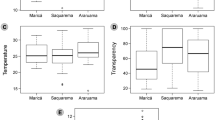Abstract
Coastal waters are important in linking zoobenthos and fish, as many coastal fishes feed on benthic prey in these habitats. Major drivers, such as eutrophication and climate change, may alter this link, whereas shifts in the importance of these drivers may induce different responses in zoobenthos and fish, respectively, potentially changing productivity of coastal ecosystems. The aim of this study was to assess in which way abundance and distribution of benthic-feeding fish and biomass of zoobenthos have changed over time in response to eutrophication (Secchi depth) and climate change (temperature and salinity), respectively. This was done by analyzing gross changes in the responses over three decades (1983–2012) and across depth zones. Eutrophication and climate change caused different though specific impacts on fish and zoobenthos, respectively. Throughout the 1980s, increasing benthic-feeding fish abundance in shallow waters (<6 m) was primarily attributed to eutrophication (decreasing Secchi depth), implying increased system productivity. During the 2000s, the effect of eutrophication levelled out, whereas temperature caused contrasting development of fish abundance at different depth zones. Shallow waters had lower fish abundances during warm years compared with colder ones, while the abundance increased in deeper, aphotic waters (6–20 m). In the deep waters, zoobenthos showed a contrasting, declining trend in biomass, coinciding with the decrease in salinity during the 2000s. This suggests altered ecosystem productivity and potential food shortage for benthic-feeding fish exploring the deep waters. An intensification of these trends is likely in the future, as climate change scenarios suggest further temperature increase and salinity decrease.





Similar content being viewed by others
References
Adill A, Mo K, Sevastik S, Olsson J, Bergström L (2013) Biologisk recipientkontroll vid Forsmarks kärnkraftverk - Sammanfattande resultat av undersökningar fram till år 2012. Aqua reports 2013:19. Sveriges lantbruksuniversitet
Ådjers K, Appelberg M, Eschbaum R, Lappalainen A, Minde A, Repecka R, Thoresson G (2006) Trends in coastal fish stocks of the Baltic Sea. Boreal Env Res 11:13–25
Andersen JH, Axe P, Backer H, Carstensen J, Claussen U, Fleming-Lehtinen V, Järvinen M, Kaartokallio H, Knuuttila S, Korpinen S, Laamanen M, Lysiak- Pastuszak E, Martin G, Møhlenberg F, Murray C, Nausch G, Norkko A, Villnäs A (2011) Getting the measure of eutrophication in the Baltic Sea: towards improved assessment principles and methods. Biogeochemistry 106:137–156
Belkin IM (2009) Rapid warming of large marine ecosystems. Prog Oceanogr 81:207–213
Bergström U, Sundblad G, Downie A-L, Snickars M, Boström C, Lindegarth M, Angeler D (2013) Evaluating eutrophication management scenarios in the Baltic Sea using species distribution modeling. J Appl Ecol 50:680–690
Beukema JJ, Essink K, Michaelis H (1996) The geographic scale of synchronized fluctuation patterns in zoobenthos populations as a key to underlying factors: climatic or man-induced. ICES J Mar Sci 53:964–971
Beukema JJ, Dekker R, Jansen JM (2009) Some like it cold: populations of the tellinid bivalve Macoma balthica (L.) suffer in various ways from a warming climate. Mar Ecol Prog Ser 384:135–145
Blaber SJM, Blaber TG (1980) Factors affecting the distribution of juvenile estuarine and inshore fish. J Fish Biol 17:143–162
Böhling P, Hudd R, Lehtonen H, Karas P, Neuman E, Thoresson G (1991) Variations in year-class strength of different perch (Perca fluviatilis) populations in the Baltic Sea with special reference to temperature and pollution. Can J Fish Aquat Sci 48:1181–1187
Bonsdorff E (2006) Zoobenthic diversity-gradients in the Baltic Sea: continuous post-glacial succession in a stressed ecosystem. J Exp Mar Biol Ecol 330:383–391
Bonsdorff E, Blomqvist E (1989) Do exceptional winters affect the zoobenthos and fish in shallow, brackish archipelago waters? An example from the northern Baltic Sea. Memo Soc Fauna Flora Fenn 65:47–53
Bonsdorff E, Blomqvist EM (1993) Biotic couplings on shallow water soft bottoms-examples from the northern Baltic Sea. Oceanogr Mar Biol Annu Rev 31:153–176
Bonsdorff E, Pearson TH (1999) Variation in the sublittoral macrozoobenthos of the Baltic Sea along environmental gradients: a functional-group approach. Aust J Ecol 24:312–326
Bonsdorff E, Blomqvist EM, Mattila J, Norkko A (1997) Long-term changes and coastal eutrophication. Examples from the Åland Islands and the Archipelago Sea, northern Baltic Sea. Oceanol Acta 20:319–329
Boström C, Bonsdorff E (1997) Community structure and spatial variation of benthic invertebrates associated with Zostera marina (L.) beds in the northern Baltic Sea. J Sea Res 37:153–166
Breitburg DL, Hondorp DW, Davias LA, Diaz RJ (2009) Hypoxia, nitrogen, and fisheries: integrating effects across local and global landscapes. Ann Rev Mar Sci 1:329–349
Casini M, Cardinale M, Arrhenius F (2004) Feeding preferences of herring (Clupea harengus) and sprat (Sprattus sprattus) in the southern Baltic Sea. ICES J Mar Sci 61:1267–1277
Cederwall H, Elmgren R (1990) Biological effects of eutrophication in the Baltic Sea, particularly the coastal zone. AMBIO 19:109–112
Cloern JE (2001) Our evolving conceptual model of the coastal eutrophication problem. Mar Ecol Prog Ser 210:223–253
Cocheret de la Morinière E, Pollux BJA, Nagelkerken I, Hemminga MA, Huiskes AHL, van der Velde G (2003) Ontogenetic dietary changes of coral reef fishes in the mangrove–seagrass–reef continuum: stable isotopes and gut-content analysis. Mar Ecol Prog Ser 246:279–289
Conley DJ, Bjorck S, Bonsdorff E, Carstensen J, Destouni G, Gustafsson BG, Hietanen S, Kortekaas M, Kuosa H, Meier HEM, Muller-Karulis B, Nordberg K, Norkko A, Nurnberg G, Pitkanen H, Rabalais NN, Rosenberg R, Savchuk OP, Slomp CP, Voss M, Wulff F, Zillen L (2011) Hypoxia-related processes in the Baltic Sea. Environ Sci Technol 43:3412–3420
Diaz RJ, Rosenberg R (2008) Spreading dead zones and consequences for marine ecosystems. Science 321:926–929
Dulvy NK, Rogers SI, Jenning S, Stelzenmuller V, Dye SR, Skjoldal HR (2008) Climate change and deepening of the North Sea fish assemblage: a biotic indicator of warming seas. J Appl Ecol 45:1029–1039
Eriksson BK, Ljunggren L, Sandström A, Johansson G, Mattila J, Rubach A, Råberg S, Snickars M (2009) Declines in predatory fish promote bloom-forming macroalgae. Ecol Appl 19:1975–1988
Fields PA, Graham JB, Rosenblatt RH, Somero GN (1993) Effects of expected global climate change on marine faunas. Trends Ecol Evol 8:361–367
Fleming-Lehtinen V, Laamanen M (2012) Long-term changes in Secchi depth and the role of phytoplankton in explaining light attenuation in the Baltic Sea. Estuar Coast Shelf Sci 102–103:1–10
Harley CDG, Hughes AR, Hultgren KM, Miner BG, Sorte CJB, Thornber CS, Rodriguez LF, Tomanek L, Williams SL (2006) The impacts of climate change in coastal marine systems. Ecol Lett 9:228–241
HELCOM (2008) Guidelines for HELCOM coastal fish monitoring sampling methods. http://www.helcom.fi/groups/monas/CombineManual/AnnexesC/en_GB/annex10/ HELCOM (2012) Indicator-based assessment of coastal fish community status in the Baltic Sea 2005–2009. Baltic Sea Environment Proceedings No. 131
Holbrook SJ, Schmitt RJ, Stephens JS Jr (1997) Changes in an assemblage of temperate reef fishes associated with a climate shift. Ecol Appl 7:1299–1310
Hüssy K, St John MA, Bottcher U (1997) Food resource utilization by juvenile Baltic cod Gadus morhua: a mechanism potentially influencing recruitment success at the demersal juvenile stage? Mar Ecol Prog Ser 155:199–208
Killick R, Eckley IA (2014) Changepoint: an R package for changepoint analysis. J Stat Software 58:1–19
Laine AO, Andersin A, Zuur AF (2007) Stratification-induced hypoxia as a structuring factor of macrozoobenthos in the open Gulf of Finland (Baltic Sea). J Sea Res 57:65–77
Lappalainen A, Rask M, Koponen H, Vesala S (2001) Relative abundance, diet and growth of perch (Perca fluviatilis) and roach (Rutilus rutilus) at Tvärminne, northern Baltic Sea, in 1975 and 1997: responses to eutrophication. Boreal Env Res 6:107–118
Lappalainen A, Westerbom M, Heikinheimo O (2005) Roach (Rutilus rutilus) as an important predator on blue mussel (Mytilus edulis) populations in a brackish water environment, the northern Baltic Sea. Mar Biol 147:323–330
Larson RJ (1980) Competition, habitat selection, and the bathymetric segregation of two rockfish (Sebastes) species. Ecol Monogr 50:221–239
Laurel BJ, Gregory RS, Brown JA, Hancock JK, Schneider DC (2004) Behavioural consequences of density-dependent habitat use in juvenile cod Gadus morhua and G. ogac, the role of movement and aggregation. Mar Ecol Prog Ser 272:257–270
Lindberg WJ, Frazer TK, Portier KM, Vose F, Loftin J, Murie DJ, Mason DM, Nagy B, Hart MK (2006) Density-dependent habitat selection and performance by a large mobile reef fish. Ecol Appl 16:731–746
MacKenzie BR, Gislason H, Möllman C, Köster F (2007) Impact of 21st century climate change on the Baltic Sea fish community and fisheries. Glob Chang Biol 13:1348–1367
Mattila J, Bonsdorff E (1988) A quantitative estimation of fish predation on shallow soft bottom benthos in SW Finland. Kieler Meeresforsch Sonderh 6:111–125
Meier HEM, Müller-Karulis B, Andersson HC, Dieterich C, Eilola K, Gustafsson BG, Höglund A, Hordoir R, Kuznetsov I, Neumann T, Ranjbar Z, Savchuk O, Schimanke S (2012) Impact of climate change on ecological quality indicators and biogeochemical fluxes in the Baltic Sea: a multi-model ensemble study. AMBIO 41:558–573
Möllmann C, Diekmann R, Müller-Karulis B, Kornilovs G, Plikshs M, Axe P (2009) Reorganization of a large marine ecosystem due to atmospheric and anthropogenic pressure: a discontinuous regime shift in the Central Baltic Sea. Glob Change Biol 15:1377–1393
Munsterhjelm R (1997) The aquatic macrophyte vegetation of flads and gloes, S coast of Finland. Acta Bot Fenn 157:1–68
Mustamäki N, Cederberg T, Mattila J (2013) Diet, stable isotopes and morphology of Eurasian perch (Perca fluviatilis) in littoral and pelagic habitats in the northern Baltic proper. Environ Biol Fish. doi:10.1007/s10641-013-0169-8
Nicolas D, Chaalali A, Drouineau H, Lobry J, Uriarte A, Borja A, Boët P (2011) Impact of global warming on European tidal estuaries: some evidences of northward migration of estuarine fish species. Reg Environ Change 11:639–649
Nye JA, Link JS, Hare JA, Overholtz WJ (2009) Changing spatial distribution of fish stocks in relation to climate and population size on the Northeast United States continental shelf. Mar Ecol Prog Ser 393:111–129
Ojaveer H, Jaanus A, MacKenzie BR, Martin G, Olenin S, Radziejewska T, Telesh I, Zettler M, Zaiko A (2010) Status of biodiversity in the Baltic Sea. PLoS one 5(9):e12467. doi:10.1371/journal.pone.0012467
Olsson J, Bergström L, Gårdmark A (2012) Abiotic drivers of coastal fish community change during four decades in the Baltic Sea. ICES J Mar Sci 69:961–970
Olsson J, Bergström L, Gårdmark A (2013) Top-down regulation, climate and multi-decadal changes in coastal zoobenthos communities in two Baltic Sea areas. PLoS one 8:e64767. doi:10.1371/journal.pone.0064767
Pearson TH, Rosenberg R (1978) Macrobenthic succession in relation to organic enrichment and pollution of the marine environment. Oceanogr Mar Biol Annu Rev 16:229–311
Pekcan-Hekim Z, Urho L, Auvinen H, Heikinheimo O, Lappalainen J, Raitaniemi J, Söderkultalahti P (2011) Climate warming and pikeperch year-class catches in the Baltic Sea. AMBIO 40:447–456
Philippart CJM, Anadón R, Danovaro R, Dippner JW, Drinkwater KF, Hawkins SJ, Oguz T, O’Sullivan G, Reid PC (2011) Impacts of climate change on European marine ecosystems: observations, expectations and indicators. J Exp Mar Biol Ecol 400:52–69
Pihl L (1986) Exposure, vegetation and sediment as primary factors for mobile epibenthic faunal community structure and production in shallow marine soft bottom areas. Neth J Sea Res 20:75–83
R Core Team (2013) R: a language and environment for statistical computing. R Foundation for Statistical Computing, Vienna
Rousi H, Laine AO, Peltonen H, Kangas P, Andersin A-B, Rissanen J, Sandberg-Kilpi E, Bonsdorff E (2013) Long-term changes in coastal zoobenthos in the northern Baltic Sea: the role of abiotic environmental factors. ICES J Mar Sci 70:440–451
Sandström A, Karås P (2002) Effects of eutrophication on young-of-the-year freshwater fish communities in coastal areas of the Baltic. Env Biol Fish 63:89–101
Segerstråle SG (1957) Baltic Sea. Geol Soc Am Mem 67:751–800
Seitz RD, Wennhage H, Bergström U, Lipcius RN, Ysebaert T (2013) Ecological value of coastal habitats for commercially and ecologically important species. ICES J Mar Sci. doi:10.1093/icesjms/fst152
Simpson SD, Jennings S, Johnson MP, Blanchard JL, Schon P-J, Sims DW, Genner MJ (2011) Continental shelf-wide response of a fish assemblage to rapid warming of the sea. Curr Biol 21:1565–1570
Snickars M, Rinne H, Salovius-Laurén S, Arponen H, O’Brien K (2014) Disparity in the occurrence of Fucus vesiculosus in two adjacent areas of the Baltic Sea—current status and outlook for the future. Boreal Environ Res 19:441–551
Suikkanen S, Pulina S, Engström-Öst J, Lehtiniemi M, Lehtinen S, Brutemark A (2013) Climate change and eutrophication induced shifts in northern summer plankton communities. PLoS one 8:e66475. doi:10.1371/journal.pone.0066475
ter Hofstede R, Hiddink JG, Rijnsdorp AD (2010) Regional warming changes fish species richness in the eastern North Atlantic Ocean. Mar Ecol Prog Ser 414:1–9
Thoresson G (1992) Handbok för kustundersökningar. Kustrapport 1992: 4. SLU website. http://www.slu.se//Documents/externwebben/akvatiska-resurser/publikationer/FIV/KLAB/PM029-%20handbok%20recip.pdf (in Swedish)
Tomczak MT, Müller-Karulis B, Järv L, Kotta J, Martin G, Minde A, Pöllumäe A, Razinkovas A, Strake S, Bucas M, Blenckner T (2009) Analysis of trophic networks and carbon flows in South Eastern Baltic coastal ecosystems. Prog Oceanogr 81:111–131
Voipio A (ed) (1981) The Baltic Sea. Elsevier Oceanography Series 30. Amsterdam, p 418
Wærn M (1952) Rocky-shore algae in the Öregrund archipelago. Acta Phytogeogr Suec 30:1–298
Wikner J, Andersson A (2012) Increased freshwater discharge shifts the trophic balance in the coastal zone of the northern Baltic Sea. Glob Chang Biol 18:2509–2519
Wood SN (2006) Generalized additive models: an introduction with R. Chapman and Hall/CRC, FL
Zuur AF, Ieno EN, Elphick CS (2010) A protocol for data exploration to avoid common statistical problems. Meth Ecol Evol 1:3–14
Acknowledgments
This paper is a deliverable of the Nordic Centre for Research on Marine Ecosystems and Resources under Climate Change (NorMER), which is funded by the Norden Top-level Research Initiative sub-programme ‘Effect Studies and Adaptation to Climate Change.’ We are grateful to Kaj Ådjers at the Government of Åland and Kerstin Mo at the Swedish University of Agricultural Sciences, Department of Aquatic Resources for providing the fish and zoobenthos data, respectively. Financial support from the Åbo Akademi University Endowment is also acknowledged.
Author information
Authors and Affiliations
Corresponding author
Additional information
Communicated by F. Bulleri.
Rights and permissions
About this article
Cite this article
Snickars, M., Weigel, B. & Bonsdorff, E. Impact of eutrophication and climate change on fish and zoobenthos in coastal waters of the Baltic Sea. Mar Biol 162, 141–151 (2015). https://doi.org/10.1007/s00227-014-2579-3
Received:
Accepted:
Published:
Issue Date:
DOI: https://doi.org/10.1007/s00227-014-2579-3




